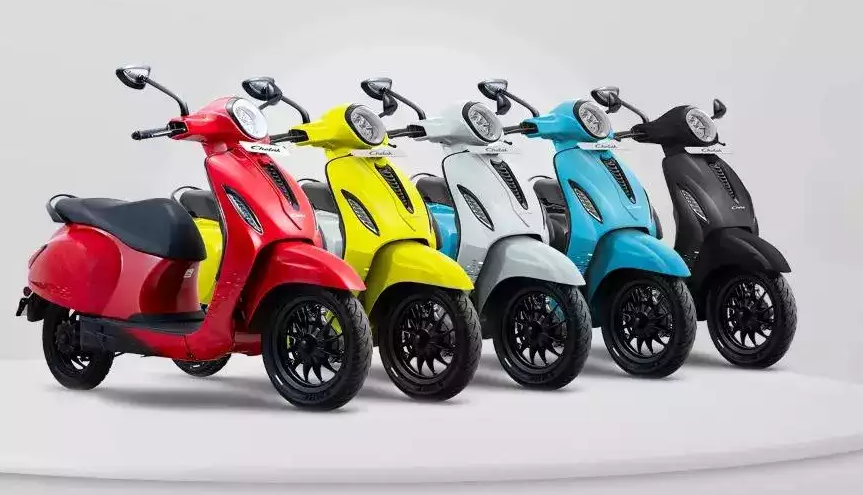
New Delhi: Bajaj Auto is pulling out all stops to expand its electric two wheeler (e2w) portfolio in a bid to attain market leadership. The e2w market has seen sharp changes in the pecking order over the last few months, with Bajaj’s Chetak briefly reaching the number two spot in September, ahead of TVS Motor Company’s iQube. Ola Electric has remained the market leader by far, throughout. But TVS sprang back in October to claim the second spot again even as Bajaj continued to snap at its heels. Now, Bajaj is bringing an “upgraded, refreshed” range of Chetak to accelerate its e2w play.“The momentum of market share acquisition should increase further with an entirely new refreshed range and upgraded range being launched beginning middle of November. These upgraded Chetaks will not only have superior and competitive propositions, but they will also significantly improve our margin structure,” Bajaj’s Executive Director Rakesh Sharma told analysts recently.
Two people close to developments said that the new range of Chetak scooters is expected across retail showrooms but slightly later, by around January next year. “The new scooters are under development but retailers haven’t been told anything specifically. No training has started as of now…there is some talk of the new Chetak models being bigger than the existing range, with bigger battery and motor, so that the brand can compete with the Ather Rizta. They may come with new price tags too,” said one of the persons.
The Rizta has been positioned as a family scooter and was available initially at a starting price of INR 109,999 (ex-showroom Bengaluru). The positioning and the pricing meant that the Rizta became one of the most affordable models in the e2w market at launch and thereafter competitors, including Bajaj Auto, brought in sub-one lakh rupee models too subsequently. But the person quoted above said that Bajaj merely tweaked the pricing on the existing Chetak (while reducing battery size etc) to launch a sub one lakh rupee model in response to Rizta earlier this year. “The new range of Chetak will be the first time when Bajaj will offer a brand new product, with probably larger seats, bigger battery etc,” this person said. But when contacted, Sharma did not confirm whether the new Chetak range will have bigger seats, bigger battery etc. “Indeed we are going to commence the introduction of the new platform mid-end November and there on. It would be best to wait for that event as we can be specific only then,” Sharma told ETAuto. At present, the Chetak comes at three price points: INR 1.35 lakh, INR 1.15 lakh and the affordable variant whose price range is INR 96000-100,000.
Meanwhile, not just new products, Bajaj is also expanding the distribution reach of Chetak, with Sharma promising availability of the electric scooter in 1000 additional outlets by January next year. This will take the total retail footprint of Chetak to 4000 outlets – these are existing Bajaj motorcycle showrooms where Chetak is also retailed. In addition, there will be an increase in the number of exclusive Chetak outlets from the current 250 .
No longer draining margins:
Bajaj’s focus on expanding the product lineup and distribution of electric scooters comes just as the company’s electric vehicle portfolio (in entirety) has stopped being a drag on its overall margins from the second quarter (July-September) of 2024-25. The profitable sales of electric three wheelers are currently the reason for the overall electric portfolio ceasing to be a drag on margins.
Bajaj’s EBITDA for Q2 “has been flat in absolute terms. Clearly, benefiting from the scale up of the very profitable electric three-wheeler portfolio and cost reduction, which we’ve spoken about over a period of time on Chetak, essentially electric two-wheelers. This portfolio has now sold a milestone one lakh units in this quarter for the very first time, which is quite significant in the journey that we’ve been making steadfastly towards electrification,” Rakesh Sharma told analysts.
The scale up on three wheelers has been offsetting the drag which Chetak brings on the EBITDA margins. In effect, Bajaj Auto’s cash burn on the electric portfolio is now flat. Perhaps with the new product lineup of Chetak, expansion of the distribution network and new pricing, the electric two wheeler share in the overall margins would also eventually turn positive. The e2w sales touched the 70,000 unit mark in Q2 against just 40,000 units in Q1 of FY25.
Freedom 125:
While the e2w portfolio is witnessing deep focus from Bajaj, the company is also upbeat about the CNG bike, Freedom 125. Till September, the company says it has retailed 10,000 of these bikes and the target for October alone was 18000 units. Two dealers, however, spoke of the entry level variants of the Freedom 125 – called ‘Drum with LED’ and ‘Drum’ – having seen a price reduction during the festival season of INR 5000 each.
Both dealers said that these variants have seen a slow offtake and that was the reason for the company to slash the price, denying that the INR 5000 reduction was a festive discount. But Sharma of Bajaj Auto said that with the increase in overall sales of Freedom 125, the company has ramped up production, to 30,000 units per month in the current quarter and 40,000 per month from the fourth quarter (January-March 2025). Bajaj has marketed this bike on the savings plank, claiming 50% savings in fuel bills versus petrol bikes.
To a question on the time taken by customers to fill up CNG across various cities, Sharma said “the waiting period (for getting the gas) is probably in minutes and seconds”. Some dealers have said that ubiquitous queues for getting CNG across pumps in big cities have been a deterrent for some potential customers of Freedom 125.

















